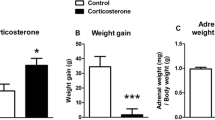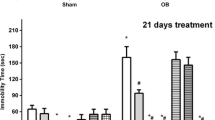Abstract
Corticotropin-releasing factor (CRF), which may serve as a neurotransmitter in the noradrenergic nucleus, locus coeruleus (LC), has been postulated to be hypersecreted in depression. The present study was designed to test the hypothesis that antidepressants interfere with CRF putative neurotransmission in the LC. The acute and chronic effects of the atypical antidepressant mianserin on LC spontaneous discharge, LC sensory-evoked discharge, LC activation by a stressor which requires endogenous CRF, and LC activation by ICV CRF were characterized in halothane-anesthetized rats. Acute IV administration of mianserin (0.0001–1.0 mg/kg) increased LC spontaneous discharge and decreased LC discharge evoked by repeated sciatic nerve stimulation in a dose-dependent manner. Additionally, mianserin (0.1 mg/kg) inhibited LC activation by hemodynamic stress (IV infusion of nitroprusside) and by ICV administration of CRF (3.0 µg). In rats chronically administered mianserin LC spontaneous and sensory-evoked discharge rates, and LC activation by CRF were similar to those of untreated rats or rats chronically administered saline. Moreover, acute IV administration of mianserin (0.1 mg/kg) to rats chronically treated with mianserin was less effective in altering LC spontaneous and sensory-evoked discharge. In contrast, LC activation by hemodynamic stress was still greatly attenuated in rats chronically administered mianserin. This is similar to the previously reported effect produced by chronic administration of the antidepressant, desmethylimipramine. The present results demonstrate that acute administration of low doses of mianserin attenuates LC activation by a variety of stimuli and suggest that tolerance developes with chronic administration to some of the effects of mianserin on LC discharge characteristics. The finding that LC activation by hemodynamic stress, which requires endogenous CRF, is attenuated after chronic mianserin administration suggests that interference with putative CRF neurotransmission in the LC may be an important common mode of antidepressant action.
Similar content being viewed by others
References
Blackshear MA, Sanders-Bush E (1982) Serotonin receptor sensitivity after acute and chronic treatment with mianserin. J Pharmacol Exp Ther 221:303–308
Bunney Jr WE, Davis JM (1965) Norepinephrine in depressive reactions. Arch Gen Psychiatry 13:483–494
Carroll B (1982) The dexamethasone suppression test for melancholia. Br J Psychiatry 140:292–304
Cummings S, Elde R, Ells J, Lindall A (1983) Corticotropin-releasing factor immunoreactivity is widely distributed within the central nervous system of the rat: an immunohistochemical study. J Neurosci 3:1355–1368
Fludder JM, Leonard BE (1979) Chronic effects of mianserin on noradrenaline metabolism in the rat brain: evidence for a presynaptic alpha adrenolytic action in vivo. Psychopharmacology 64:329–332
Foote SL, Cha CI (1988) Distribution of corticotropin-releasing factor-like immunoreactivity in brainstem of two monkey species (saimiri sciureus andmacaca fasicularis): an immunohistochemical study. J Comp Neurol 276:239–264
Gandolfi O, Roncada P, Dall'olio R (1989) Effects of repeated trazodone administrations on serotonergic neurotransmission: biochemical studies. Prog Neuropsychopharmacol Biol Psychiatry 13:941–952
Gold PW, Loriaux DL, Roy A, Kling MA, Calabrese JR, Kellner CH, Nieman LK, Post RM, Pickar D, Gallucci W, Averginos P, Paul S, Oldfield EH, Cutler Jr GB, Chrousos PG (1986) Responses to cortico-releasing hormone in the hypercortisolism of depression and Cushings disease. New Engl J Med 314:1329–1342
Goodlet I, Mireylees SE, Sugrue MF (1977) Effects of mianserin, a new antidepressant, on the in vitro and in vivo uptake of monoamines. Br J Pharmacol 61:307–313
Gorea E, Adrien J (1988) Serotonergic regulation of noradrenergic coerulean neurons: electrophysiological evidence for the involvement of 5-HT2 receptors. Eur J Pharmacol 154:285–291
Holsboer F, Gerken A, von Bardeleben U, Grimm W, Beyer H, Muller OA, Stalla GK (1986) Human corticotropin-releasing hormone in depression: correlation with thyrotropin secretion following thyrotropin-releasing hormone. Biol Psychiatry 21:601–611
Lesch KP, Laux G, Schulte HM, Pfuller H, Beckmann H (1988) Corticotropin and cortisol response to human CRH as a probe for HPA system integrity in major depressive disorder. Psychiatr Res 24:25–34
Marsden CA, Slight AJ, Fone KCF, Jonson JV, Crespi F, Martin KF, Garrett JC, Bennett GW (1989) Functional identification of 5-HT receptor subtypes. Comp Biochem Physiol 93A: 107–114
Maura G, Pittaluga A, Ulivi M, Raiteri M (1988) Enhancement of endogenous GABA release from synaptosomal preparations is mediated by alpha 2 adrenoceptors pharmacologically different from alpha 2 autoreceptors. Eur J Pharmacol 157:23–29
Nemeroff C, Widerlov E, Bissette GT, Walleus H, Karlson I, Eklund K, Kilts C, Loosen P, Vale W (1984) Elevated concentrations of CSF corticotropin-releasing factor-like immunoreactivity in depressed patients. Science 226:1342–1344
Nemeroff CB, Owens MJ, Bissette GT, Andorn AC, Stanley M (1988) Reduced corticotropin-releasing factor (CRF) binding sites in frontal cortex of suicide patients. Arch Gen Psychiatry 45:577–579
Pinder RM, van Delft AML (1983) The potential therapeutic role of the enantiomers and metabolites of mianserin. Br J Clin Pharmacol 15:269S-276S
Plotsky PM, Vale W (1984) Hemorrhage-induced secretion of corticotropin-releasing factor-like immunoreactivity into the rat hypophyseal portal circulation and its inhibition by glucocorticoids. Endocrinology 114:164–169
Raiteri M, Maura G, Versace P (1983) Functional evidence for two stereochemically different alpha 2 adrenoceptors regulating central norepinephrine and serotonin release. J Pharmacol Exp Ther 224:679–684
Rasmussen K, Aghajanian GK (1986) Effects of hallucinogens on spontaneous and sensory-evoked locus coeruleus unit activity in the rat: reversal by selective 5-HT2 antagonists. Brain Res 385:395–400
Rasmussen K, Glennon RA, Aghajanian GK (1986) Phenethylamine hallucinogens in the locus coeruleus: potency of action correlates with rank order of 5-HT2 binding affinity. Eur J Pharmacol 132:79–82
Sachar EJ, Hellman L, Fukushima DK, Gallagher TF (1970) Cortisol production in depressive illness. Arch Gen Psychiatry 23:289–298
Sakanaka M, Shibasaki T, Lederes K (1987) Corticotropin-releasing factor-like immunoreactivity in the rat brain as revealed by a modified cobalt-glucose oxide-diaminobenzidene method. J Comp Neurol 260:256–298
Schildkraut JJ (1965) The catecholamine hypothesis of affective disorders: a review of supporting evidence. Am J Psychiatry 122:509–522
Simson PE, Weiss JM (1987) Alpha-2 receptor blockade increases responsiveness of locus coeruleus neurons to excitatory stimulation. J Neurosci 7:1732–1740
Stokes PE, Sikes CR (1987) Hypothalamic-pituitary-adrenal axis in affective disorders. In: Meltzer HY (eds) Psychopharmacology: the third generation of progress. Raven Press, New York, pp 589–607
Vale W, Spiess J, Rivier C (1981) Characterization of a 41-residue ovine hypothalamic peptide that stimulates secretion of corticotropin and beta-endorphin. Science 213:1394–1397
Valentino RJ (1988) CRF effects on central noradrenergic neurons: relationship to stress. In: Chrousos GP, Loriaux DL, Gold PW (eds) Mechanisms of physical and emotional stress. Plenum Press, New York pp 47–64
Valentino RJ (1989) Corticotropin-releasing factor: putative neurotransmitter in the noradrenergic nucleus locus ceruleus. Psychopharmacol Bull 25:306–311
Valentino RJ, Foote SL (1987) Corticotropin-releasing factor disrupts sensory responses of brain noradrenergic neurons. Neuroendocrinology 45:28–36
Valentino RJ, Foote SL (1988) Corticotropin-releasing hormone increases tonic but not sensory-evoked activity of noradrenergic locus ceruleus neurons in unanethetized rats. J Neurosci 8:1016–1025
Valentino RJ, Wehby RG (1988) Corticotropin-releasing factor: evidence for a neurotransmitter role in the locus ceruleus during hemodynamic stress. Neuroendocrinology 48:674–677
Valentino RJ, Foote SL, Aston-Jones G (1983) Corticotropin-releasing factor activates noradrenergic neurons of the locus ceruleus. Brain Res 270:363–367
Valentino RJ, Curtis AL, Parris DG, Wehby RG (1990) Antidepressant actions on brain noradrenergic neurons. J Pharmacol Exp Ther 253:833–840
van Riezen H, Pinder RM, Nickolson VJ, Hobbelen P, Zayed I, Van Der Veen F (1981) Mianserin, a really different antidepressant. In: Goldberg ME (ed) Pharmacological and biochemical properties of drug substances, vol. 3. American Pharmacetical Association Academy of Pharmaceutical Sciences, Washington, DC pp 1–38
Author information
Authors and Affiliations
Additional information
This work was supported by U.S.P.H.S. Grants MH42796, MH40008, MH00840, and a NARSAD award to A.L.C.
Rights and permissions
About this article
Cite this article
Curtis, A.L., Valentino, R.J. Acute and chronic effects of the atypical antidepressant, mianserin on brain noradrenergic neurons. Psychopharmacology 103, 330–338 (1991). https://doi.org/10.1007/BF02244286
Received:
Revised:
Issue Date:
DOI: https://doi.org/10.1007/BF02244286




